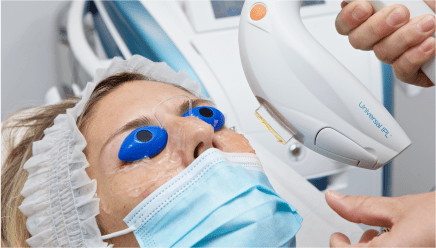Dry eye / Dry Eye Treatment
Treatment
Since it is generally a chronic and progressive eye disorder, the long-term treatment until now has usually been:
Artificial tears
The most common traditional treatment involves using artificial tears without preservatives to help keep eyes moist. They are water-based isotonic or hypotonic saline solutions that help the artificial tears to remain on the eye surface for longer, in addition to preventing any kind of contamination or eye irritation.
Topical cyclosporine
For highly complex cases, patients may use eye drops with growth factors obtained from their own serum and immunosuppressants for combatting inflammation, such as cyclosporine A.
Meibomian gland probing
This is a non-invasive surgical procedure that involves opening the outlet duct of the meibomian glands, extracting the oil content from inside and applying an antibiotic to normalise the microbial flora. It is a painless procedure using superficial sedation.
Exfoliation of the free margin of the eyelids and glandular drainage
This is one of the least invasive techniques. It involves using exfoliation to remove the membrane that covers the meibomian glands.
Other treatments
Some other treatments that have been used, which must be prescribed by an ophthalmologist, include: topical corticosteroids, sodium hyaluronate, autologous serum eye drops, pilocarpine (for patients with Sjögren’s syndrome) and hyaluronic acid in combination with other products, such as xanthan gum or HP-guar, among others.
Pulsed light treatment for dry eye
In addition to the procedures mentioned previously, the Dry Eye Unit at Oftalvist has moved towards the use of new pulsed light technologies which offer much more accurate and useful data so we can establish a safer and more effective long-term treatment.
For this we use a high-frequency pulsed laser technology called ThermaEye, a painless and non-invasive treatment that stimulates the meibomian glands without the need for surgery.

Benefits of pulsed light
The pulsed light helps to stimulate circulation and acts on the nerve endings in order to control the production and secretion of oils, improving the patient’s vision with excellent results.
Advantages of pulsed light for the patient:
• It is done in the consultation itself. It is not a surgical procedure.
• Painless.
• Immediate results from the first session. More durable.
• It also helps to treat blepharitis problems.
How is a session with pulsed light?
Each session lasts around 5-10 minutes. The pulsed light treatment to be followed in each session will consist of the following action protocol:
→ We clean the skin of the area to be treated with a fragrance-free water-based micellar cleanser.
→ We put the eye protectors on the patient. We will cover moles, tattoos and other injuries that are in the area to be treated.
→ A layer of colorless hydrogel will be applied to the cheekbone and temporal area.
→ The pulsed light handpiece is placed on the skin with hydrogel, starting with the most external, temporal area, making sure that it is perpendicular to the plane of the skin without applying excessive pressure. A series of shots is made, advancing towards the nasal region and ensuring that there is no overlap of the treated area in each pulse.
→ We carry out an expression of the eyelid.
→ We will carry out the same procedure for the other eye.
Dry eye? More effective treatment with pulsed light
- → High intensity pulsed light technology non-invasive and painless
- → Stimulates the Meibomian glands (MGD) without the need for surgery




